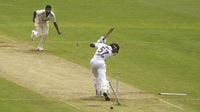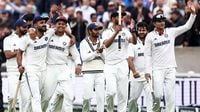Cricket fans in Ahmedabad witnessed a display of dominance as India asserted its supremacy over the West Indies in the opening Test at the Narendra Modi Stadium, but the lopsided nature of the contest has sparked debate across the cricketing world. With India declaring their first innings at a commanding 448-5 on October 4, 2025, and the West Indies struggling to recover from an early collapse, the gulf between the two teams was laid bare for all to see.
India’s first innings was a celebration of batting prowess, featuring centuries from Lokesh Rahul (100), Dhruv Jurel (125, marking his maiden Test ton), and the ever-reliable Ravindra Jadeja, who finished unbeaten on 104. The hosts established a daunting 286-run lead after bowling out the West Indies for just 162 on the opening day. The visitors’ woes deepened as their second innings faltered; by lunch on day three, they were reduced to 66-5 after 27 overs, still trailing by 220 runs and staring down the barrel of another defeat.
Jadeja, who shone with both bat and ball, picked up 3-30 in the morning session, dismantling the West Indies’ top order with surgical precision. Mohammed Siraj and Kuldeep Yadav chipped in with a wicket apiece, compounding the visitors’ misery. West Indies opener Tagenarine Chanderpaul fell for 8 after just 7.2 overs, with Nitish Reddy’s sharp catch at square leg setting the tone for the innings. Jadeja’s early introduction to the attack paid immediate dividends as he removed John Campbell for 14, and soon after, Brandon King was caught at slip for four. Yadav’s delivery to bowl Roston Chase for one further highlighted the visitors’ struggles against spin.
Only Alick Athanaze, who battled through 50 deliveries for his 27 not out at lunch, and Justin Greaves, unbeaten on 10, showed any real resistance. The West Indies’ inability to forge partnerships or withstand the relentless Indian attack was evident throughout the match. For the first time in 15 years, India played a home Test without the legendary trio of Virat Kohli, Rohit Sharma, and Ravichandran Ashwin, all of whom retired over the past season. Yet, the new generation seized the moment, ensuring the team didn’t skip a beat.
The West Indies’ decline in Test cricket has been a talking point for years, but rarely has it been so stark. Former Indian captain Sunil Gavaskar didn’t mince words in his assessment, observing, “There is not a cricket lover in the world who isn’t disappointed by the performances of the West Indies Test teams over the last couple of decades or so.” Gavaskar lamented the team’s lack of application and hard work in the longer format, noting, “They have talent, but it seems like the application and hard work required in Test matches are just a tad too much.”
The legendary opener was particularly critical of the West Indies’ pace attack, describing it as a shadow of the fearsome units of the past. “To see their new-ball attack in the first Test in Ahmedabad was a shock to those who have grown up seeing the ball whistle past the batters’ noses at least two or three times in an over,” Gavaskar said. He singled out Jayden Seales as the only bowler who looked the part, while the rest “looked more like net bowlers than international ones.” Gavaskar also noted the lack of aggressive intent, questioning, “Is this really the West Indies pace attack?”
Despite the gloomy outlook, Gavaskar found a silver lining in the performances of Justin Greaves and Alick Athanaze, who at least tried to dig in during the match. He also reminisced about the glory days of West Indies cricket, name-dropping legends like the Three Ws, Garfield Sobers, Viv Richards, and Brian Lara. “There is simply nobody in this current team who looks like getting a million country miles close to them,” he remarked, underlining the challenge facing the current generation.
The reasons for West Indies’ ongoing struggles go beyond the pitch. Test captain Roston Chase, speaking after the defeat, pointed to systemic issues plaguing Caribbean cricket. “I think the systems in the Caribbean are a bit poor in terms of training facilities and stuff,” Chase told reporters. He acknowledged the financial constraints and substandard infrastructure, saying, “There is obviously a struggle in the Caribbean for finances. So whatever help we can get, if they are planning to get the help, I hope that we do get it so that we could strengthen the infrastructure for cricket.”
Chase didn’t shy away from the team’s shortcomings, admitting, “We’ve not been able to at least bat 80 overs, bat a day or even get at least 250 or 300 runs on the board. Anytime you win a toss in a test match and bat and you don’t bat out the first day, you’re always going to be in trouble.” He also highlighted the challenges posed by Caribbean pitches and slow outfields, which he believes hinder long innings and high scores. Nevertheless, Chase insisted that players must take responsibility for their performances, regardless of external factors.
Adding another layer to the post-match conversation, former Indian opener Aakash Chopra voiced his disappointment over the absence of pink-ball Test matches in the series. In a video statement, Chopra argued that such fixtures would have provided a sterner test for the Indian team and better preparation for future overseas challenges. “Why don’t we play pink-ball Test matches? When we go to play the Border-Gavaskar Trophy, we play a pink-ball Test match. We play in Adelaide and lose there. However, we play one Test in two or three years. Why do we play?” Chopra questioned, suggesting that the Board of Control for Cricket in India (BCCI) missed an opportunity to inject excitement and competition into the series.
Chopra advocated for both Tests against the West Indies to be played with the pink ball, arguing, “There is no excitement, competition, contest, and skill level. At least the opposing team might become slightly competitive. Our players might be challenged a little more.” He called on the BCCI to consider the long-term benefits of hosting more pink-ball Tests at home, both for player development and for maintaining fan engagement.
The West Indies’ defeat in Ahmedabad marked their 25th consecutive Test without a win against India, a streak dating back to 2002. Their struggles have been compounded by a recent 3-0 series whitewash at home against Australia, and with the second Test scheduled to begin in New Delhi on October 10, 2025, the visitors face an uphill battle to avoid another series sweep.
As the cricketing world reflects on the first Test, questions abound: Can Daren Sammy, the charismatic coach and former captain who led the West Indies to two ICC T20 World Cup titles, inspire his side to greater heights in the longer format? Will the West Indies Cricket Board heed calls for better infrastructure and investment? And will India embrace the challenge of pink-ball cricket at home to keep raising its own standards?
For now, the action shifts to New Delhi, where the West Indies will look to regroup and India will aim to maintain its stranglehold. The cricketing fraternity watches on, hoping for a contest worthy of the proud histories of both teams.





